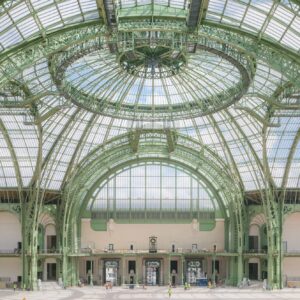There are moments in a city’s life when a building transcends its brick, glass, and stone to become a living metaphor for resilience and reinvention. Paris, the eternal city of light, has once again found its architectural pulse to engender anew with the long-awaited reopening of the Grand Palais. After a transformative four-year renovation, this monumental Beaux-Arts masterpiece welcomes the public back into its luminous embrace, fusing historic grandeur with contemporary relevance.
A Jewel of the Belle Époque
The Grand Palais has always been more than an exhibition hall. Conceived for the 1900 Exposition Universelle, it was a testament to human ingenuity and the spirit of modernity that defined the turn of the 20th century. Its bold glass vault, intricate ironwork, and imposing stone façade reflected France’s desire to assert itself as a cultural and technological leader. From the moment its massive nave first opened to visitors in 1900, it became an icon of Parisian life—hosting art fairs, fashion shows, horse shows, and even military hospitals during wartime.
The Grand Palais’ architecture symbolizes the audacious optimism of the Belle Époque: a marriage of industrial innovation and classical aesthetics. Designed by architects Henri Deglane, Albert Louvet, Albert Thomas, and Charles Girault, it combined cutting-edge engineering with neoclassical ornamentation, creating a space that felt both futuristic and timeless.
The Road to Renewal
By the 2010s, the wear and tear of over a century had taken its toll. Leaks, structural weaknesses, and outdated facilities began to hinder the Grand Palais’ potential. In 2017, it was decided that a comprehensive restoration was not just desirable—it was essential. The plan called for the first full-scale renovation in the building’s history, a project that would balance delicate historical preservation with modern upgrades to meet 21st-century standards.
The renovation, led by architect François Chatillon, tackled formidable challenges: restoring 17,500 square meters of glass roof panels, reinforcing the iron and steel skeleton, repairing elaborate mosaics, and improving energy efficiency and accessibility throughout. This was not merely a facelift but a reimagining of how the Grand Palais could serve future generations.
Perhaps the most symbolic aspect of the renovation was the meticulous cleaning and repairing of the glass roof—the largest in Europe. The roof, often referred to as Paris’ “crystal cathedral,” once again bathes the interior in natural light, reconnecting the structure to the original vision of its creators. The renewed transparency serves as a metaphor for cultural openness and creative vitality.
Engineering Meets Artistry
What distinguishes the Grand Palais from other monumental buildings is its ability to merge technical brilliance with artistic soul. The iron framework that supports the vast glass canopy is a marvel of engineering, echoing the boldness of the Eiffel Tower. During renovation, engineers and artisans worked hand in hand, using both historical techniques and state-of-the-art technology to preserve the original integrity.
Special attention was paid to the intricate mosaics, friezes, and sculptural embellishments adorning the façade and interior. These were painstakingly restored by specialized craftsmen, many of whom represent France’s rich tradition of métiers d’art—highly skilled trades such as stonemasonry, ironwork, and mosaic art. Their dedication ensures that visitors today can experience the building’s ornamentation as it might have appeared in 1900.
A Cultural and Social Catalyst
As a venue, the Grand Palais has always adapted to the spirit of the times. From hosting the groundbreaking Salon des Indépendants where avant-garde artists like Matisse and Braque shocked conservative critics, to serving as the site for Karl Lagerfeld’s extravagant Chanel shows, it has continuously mirrored Paris’ dynamic cultural evolution.
With its reopening, the Grand Palais promises to reaffirm its role as a social and cultural nexus. The first major event to inaugurate the revitalized space is an immersive digital art exhibition dedicated to the theme of “Light and Movement,” symbolizing both the building’s architectural ethos and its renewed energy. Future programming will continue to span fine arts, fashion, science, and even large-scale sporting events, including its scheduled role in the Paris 2024 Olympic Games as the venue for fencing and taekwondo.
A Symbol for Our Time
In an age when cities grapple with balancing preservation and progress, the Grand Palais stands as a paragon of how heritage can be a foundation rather than an obstacle. Rather than freezing the building in time, the renovation team embraced an evolving narrative—retaining the bones of the past while infusing it with a contemporary heartbeat.
The reimagined spaces now include upgraded technical installations, improved accessibility for disabled visitors, and enhanced environmental systems aimed at reducing energy consumption. The result is a structure that remains authentic yet forward-thinking, much like Paris itself.
Economic and Urban Impression
Beyond its aesthetic and cultural significance, the Grand Palais’ reopening is expected to generate considerable economic benefits for Paris. The renovation itself created hundreds of jobs in the artisan and construction sectors, reaffirming the importance of traditional crafts. Going forward, the revitalized venue will attract millions of visitors annually, boosting the hospitality, retail, and tourism industries.
Its strategic location on the Champs-Élysées axis further cements its role as a linchpin of Parisian urban life. Visitors will once again stroll from the Petit Palais across to the Seine, through the Tuileries Gardens, and onward to the Louvre, reviving the rhythm of the city’s cultural arteries.
A Testament to Craftsmanship
The Grand Palais is as much a triumph of collective will as it is of individual brilliance. The renovation showcased France’s unique ecosystem of heritage preservation—where architects, artisans, engineers, historians, and policymakers collaborate under a shared vision. In an era dominated by disposable culture, such projects remind us of the irreplaceable value of patience, precision, and continuity.
One cannot overlook the poetic dimension of the building’s resurrection. As the shimmering glass canopy reclaims the Parisian sky, it speaks to deeper human desires: the longing for light, beauty, and connection across generations. Just as it inspired visitors at the dawn of the 20th century, it continues to invite us to marvel, to reflect, and to dream.\
Looking Forward
The Grand Palais’ reopening is not merely a return to what was; it’s an invitation to imagine what could be. Plans are already underway for future exhibitions that embrace digital technology, immersive installations, and interdisciplinary collaborations. The building will serve as a living laboratory for cultural expression, offering a platform for voices from around the world to engage with French and European audiences.
By opening its doors to new forms of art and discourse, the Grand Palais positions itself at the vanguard of cultural innovation, ready to tackle themes as varied as climate change, social justice, and the evolution of aesthetics in the digital age.
Visitors’ Reactions
Early visitors have expressed awe at the transformation. Many noted that the space feels both familiar and brand-new, a delicate equilibrium that speaks to the project’s success. For Parisians, the Grand Palais embodies a sense of civic pride—a reminder that their city, often mythologized as unchanging, remains vibrant and responsive.
International visitors, too, see it as a must-visit pilgrimage site, combining architectural brilliance with a continually evolving program of exhibitions and events. In a post-pandemic world hungry for shared experiences and collective wonder, such spaces feel more vital than ever.
A Beacon of Continuity and Change
As the Grand Palais reopens, it once again becomes a beacon on the Parisian skyline—its iron ribs and glass skin glowing with promise. The building’s journey from an architectural marvel of 1900 to a 21st-century cultural hub mirrors the journey of Paris itself: resilient, radiant, and eternally in dialogue with its past and future.
Through its meticulous renovation, the Grand Palais teaches us that cultural heritage is not static but a living continuum. In restoring and renewing this architectural jewel, Paris offers the world a profound lesson in how to honor legacy while embracing innovation.
Standing beneath its vast nave, one feels the weight of history and the lightness of possibility coalesce into a single, transcendent moment. In that shimmering space, we glimpse not just a building reborn, but the spirit of a city eternally willing to dream.
No comments yet.








